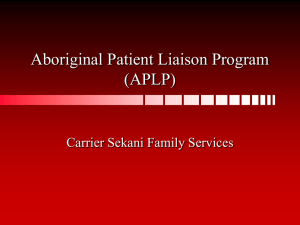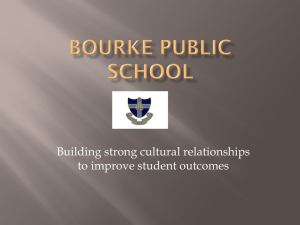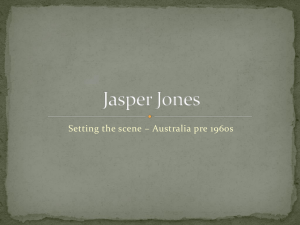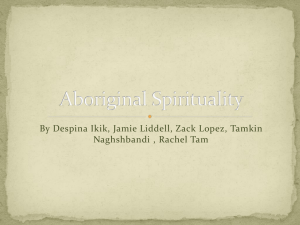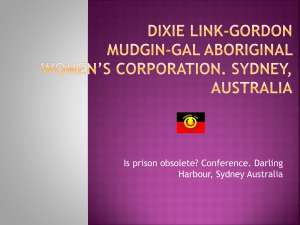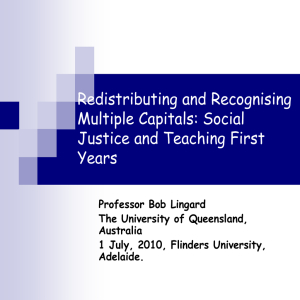8 Ways Powerpointx
advertisement
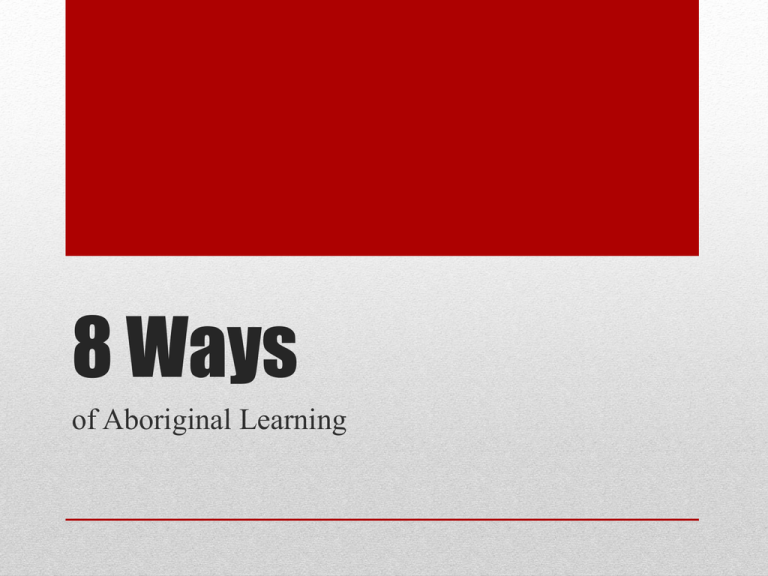
8 Ways of Aboriginal Learning Story-based, Flexibly-planned, Values-based, Transformative, Nature-centred, Adaptive, Authentic, Communal, Connected, Independent, Emotional, Responsive, Place-based, Holistic, Modelled, Cooperative, Spontaneous, Inquiring, Reflective, Creative, Experiential, Problem-based, Imitative, Person-oriented, Auditory, Visual, Non-verbal, Imaginal, Kinaesthetic, Trial and error, Repetitive, Oral. Aboriginal pedagogies are: • that culture impacts on optimal pedagogy for all learners. • that there is common ground between Aboriginal pedagogies and the optimal pedagogies for all learners. • that a practical framework is needed for teachers to be able to organise and access this knowledge in cultural safety. • and finally that a reconciling interface approach is needed to harmonise the relationship between Aboriginal and non-Aboriginal pedagogical systems. Review of the literature and research on Aboriginal pedagogy found: 8 Aboriginal Ways of Learning . Deconstruct/Reconstruct Learning Maps Community Links Symbols and Images Non-verbal Land-links Story-sharing Non-linear There is common ground between Aboriginal pedagogies and the optimal pedagogies for all learners There is a broad consensus in the literature that the Aboriginal learner “… concentrates on understanding the overall concept or task before getting down to the details.” Learning wholes rather than parts Students master activities and texts beginning with the whole structure, rather than a series of sequenced steps Holistic knowledge, balance of communal and individual needs, wholes to parts, observation before action Deconstruct/ Reconstruct Teachers use diagrams or visualisations to map out processes for students to follow Making those overall shapes of structures in texts, activities and courses explicit in a visual way for Aboriginal learners Knowledge stages/processes, navigating mental landscapes, visual records/sites of Law/Story Learning Maps This way of learning draws together the research describing Aboriginal pedagogy as group-oriented, localised and connected to real-life purposes and contexts Aboriginal teaching refers to community life and values Kinship, community, culture base, communal governance/knowledge/ownership Community Links This way of learning enfolds the recurring concept that our students are primarily visual-spatial learners But it goes beyond that, as in our way a teacher would utilise all the senses to build symbolic meaning in support of learning new concepts in classes, as a specifically Indigenous pedagogy involving the use of both concrete and abstract imagery Symbols, signs, pictures, imaginings, messages, designs and images Symbols and Images Kinaesthetic, hands-on learning is a characteristic element of this Aboriginal pedagogy Another element is the role of body language in Indigenous pedagogy and the use of silence as a feature of Aboriginal learning and language use Unspoken/instinctive/ancestral knowledge, signing, body language, communicative silences Non-verbal This pedagogy is about connecting and relating classroom learning to the land Aboriginal pedagogies are drawn from the living landscape …linking ancestral and personal relationships with a place Knowledge of/connection to land, waters, climate, skies, plants, animals and place Land-links This way of learning makes use of personal narratives in knowledge transmission and transformation It has long been observed that Elders teach using stories, drawing lessons from narratives to actively involve learners in introspection and analysis Stories, histories, songs and yarning Story-sharing Aboriginal students can have an indirect (rather than direct) orientation to learning concepts, as can be seen in the avoidance of direct questioning and in the avoidance of direct instruction and behaviour This way of learning is about presenting learning in cyclic and indirect ways – but also about avoiding dichotomies by finding common ground between diverse viewpoints Non-linear/contradictory/"irrational"/creative ideas, circular logic, indirect processes/management, adaptive capacity Non-linear How we learn - culture way… 1. We connect through the stories we share. 2. We picture our pathways of knowledge. 3. We see, think, act, make and share without words. 4. We keep and share knowledge with art and objects. 5. We work with lessons from land and nature. 6. We put different ideas together and create new knowledge. 7. We work from wholes to parts, watching and then doing. 8. We bring new knowledge home to help our mob. Story Sharing: Approaching learning through narrative. Learning Maps: Explicitly mapping/visualising processes. Non-verbal: Applying intra-personal and kinaesthetic skills to thinking and learning. Symbols and Images: Using images and metaphors to understand concepts and content. Land Links: Place-based learning, linking content to local land and place. Non-linear: Producing innovations and understanding by thinking laterally or combining systems. Deconstruct/Reconstruct: Modelling and scaffolding, working from wholes to parts (watch then do). Community Links: Centring local viewpoints, applying learning for community benefit. http://8ways.wikispaces.com/



